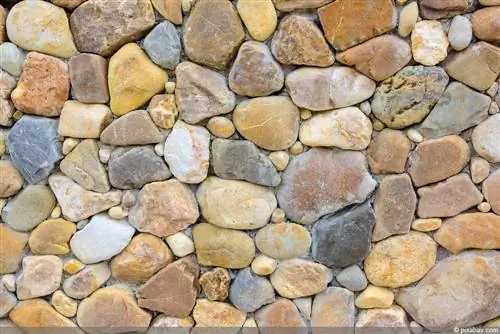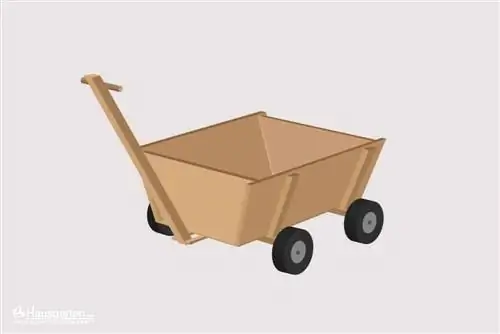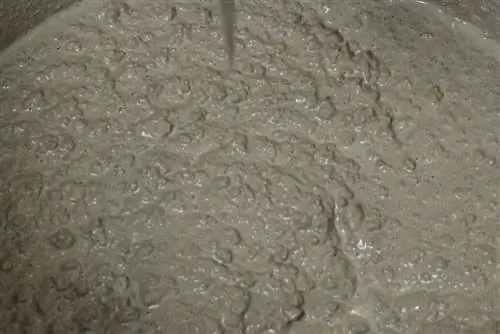- Author admin [email protected].
- Public 2023-12-17 03:39.
- Last modified 2025-01-24 12:45.
Reasonably skilled hobby craftsmen can also build concrete furniture themselves. There are different types of concrete to choose from, which are either better suited for indoor or outdoor use.
Composition
Concrete is a modern building material that can be used for many purposes. It is mainly used in house and road construction, but is now also becoming increasingly popular in the construction of furniture. At first glance, the production of the building material seems quite simple. However, correctly mixing and combining the various types of concrete requires a high level of specialist knowledge and craftsmanship in order to obtain a high-quality product. Basically, the ingredients for a usable concrete mix come from nature. In this context, the aggregates determine whether the concrete for the furniture has a rather fine or slightly coarser surface. This aspect is then expressed in the size of the pores, and the structure can be determined using the formwork.
- Base is cement, which consists of limestone and clay
- Can be mixed with gravel, grit, crushed or quartz sand
- At the end a lot of water is added
- Mix individual ingredients into a smooth mixture
- Composition determines the characteristics of the concrete
- This includes weight, insulating properties and strength
- Important aspect is protection against moisture, fire and sound
- Specialist retailers have ready-made furniture concrete on offer
Tip:
You can add bamboo or fiberglass fabric to your DIY concrete mix. In this way, the stability of the furniture can be significantly increased without it becoming extremely heavy.
Types of concrete
For simple furniture, the prefabricated concrete mixes available at hardware stores are basically sufficient. This means users know exactly how heavy the concrete furniture will be and how long it will have to dry. Anyone who has a little technical skill and previous knowledge of this can also mix concrete mixes themselves. In addition to the amount required, the resulting weight must always be taken into account. For large-scale DIY projects indoors, only types of concrete with a low weight should be used. Such mixtures are mixed with pumice stone or expanded clay; these materials promote air inclusions and thus reduce the average density. Otherwise, problems with the statics can arise, especially in older buildings. In extreme cases, concrete furniture that is too heavy can even crash through the ceiling and cause serious damage.
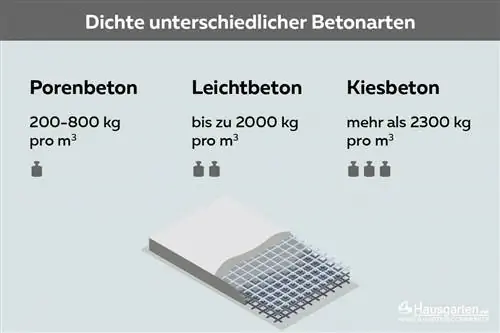
- Only use aerated concrete for interior areas
- Has density of about 200 to 800 kg per cubic meter
- Lightweight concrete has a density of up to 2000 kg per cubic meter
- Use durable gravel concrete in outdoor areas
- Has a density of more than 2300 kg per cubic meter
- However, large and thin plates can break quickly
- Incorporate metal mesh for more stability
- Generally, concrete is a building material in a simple gray
- Color pigments can also be stirred in for concrete furniture
- There are many different colors to choose from
- Anthracite, blue, yellow, green, red or black are possible
Note:
With regard to concrete furniture, it can be said that the finer the concrete mixture is mixed, the better and more appealing the result will be.
Areas of application
There are extremely many uses for concrete furniture, both in the house and in the garden and on the terrace. Due to their long durability and robust and weatherproof properties, concrete furniture is particularly popular in gardening and can be left outside all year round. The pieces of concrete furniture can be designed according to your wishes and the corresponding site conditions. Even difficult corners and unusually shaped areas are no problem with this flexible building material. With proper care and repairs in the event of any damage, the attractive appearance of the concrete furniture is maintained over the long term. The obvious disadvantage of concrete furniture, however, is its heavy weight. A simple bench made of the building material can weigh more than two hundred kilograms.
- Ideally, set up directly at the installation site
- If possible, prefer thin constructions
- Building material looks futuristic, cool, modern and pure
- Good for tables, side tables, cupboards and shelves
- Can also be used for benches, stools, sofas and chairs
- Perfect for kitchen countertops and sinks
- Possible as a replacement for tiles in the bathroom
- Optimal for garden furniture, plant pots and table tennis tables
- Also conceivable as a building material for beds and lamp bases
- Make seating and lying areas comfortable with pillows and mattresses
- Complete furniture with glass, metal or wooden parts
Note:
Due to the high weight, it is no longer so easy to move it after construction. For this reason, precise planning, including the specific location, is extremely important when making furniture from concrete.
Formwork
In order to produce furniture from the functional building material, appropriate formwork is necessary. This is a negative mold for the concrete piece of furniture that will be created later. Since the concrete mix is initially liquid, it must be poured into the desired shape. The building material can dry and harden there. The formwork should take up as little space as possible in order to keep the final weight low. However, sufficient volume is required so that the subsequent concrete element does not break under load.
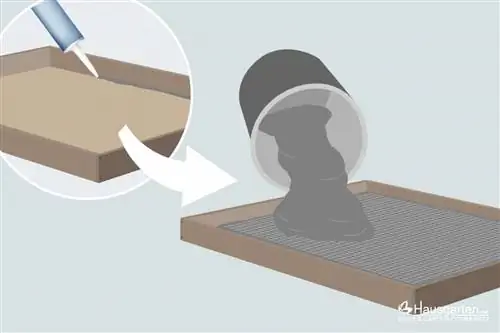
Since the furniture has to withstand both its own weight and other loads, its load capacity is a crucial factor for quality. Existing shapes and materials from the workshop can be used for the formwork. The surfaces of the shells provide the structure of concrete furniture, for example smooth or structured.
- Formwork must be solid and precise
- Vessels should taper downwards
- This is the only way to easily remove the end product
- Round buckets and barrels are ideal for small tabletops
- Stable vessels made of wood or plastic are well suited as molds
- This includes boxes and crates of various dimensions
- Build your own individual shapes from wooden boards and slats
- Wooden elements can be screwed securely
- Can therefore also withstand a high concrete mass
- Set corner joints and coves with silicone
- Before pouring, treat the mold with formwork oil
- Does not leave any discoloration on the building material
Protection of surfaces
Even with concrete furniture, the surfaces must be adequately protected against moisture, discoloration and dirt, especially outdoors. This requires comprehensive sealing of the concrete. Only conventional oils and waxes for normal pieces of furniture do not provide sufficient and lasting protection against external influences.
- First sealing makes the concrete furniture weatherproof
- Colorless products from specialist retailers are ideal
- Clear paint enhances color and improves aesthetics
- Finally polish and sand with lamb's wool
- Surfaces become smooth and supple, similar to soapstone
- Renew waterproofing at regular intervals
- This is how the material maintains its special characteristics in the long term




